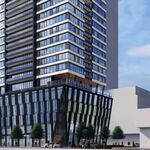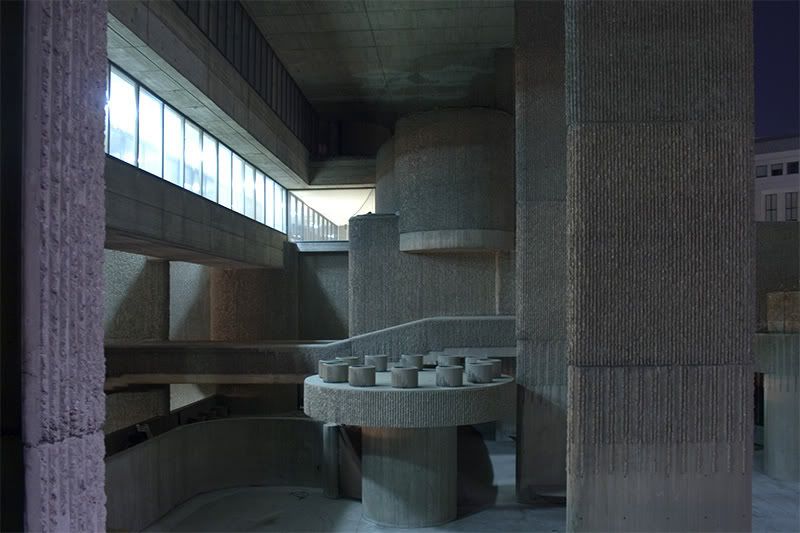adma
Superstar
http://blogs.guardian.co.uk/art/2008/06/dont_knock_brutalism.html
Steve Rose
Don't knock brutalism
This stark architectural style became synonymous with 70s ugliness, but is it about to undergo a renaissance?
June 26, 2008 11:45 AM
No PR firm would have dreamt up the word "brutalism". The term was derived from Le Corbusier's "Béton brut"- French for "raw concrete", the movement's preferred material - rather than anything to do with brutality, with which it has sadly become better associated. In the popular imagination, brutalism is synonymous with harsh, hostile, ugly architecture (or death metal). Two key examples of the movement are currently under threat, Birmingham Central Library and Robin Hood Gardens, and both have sparked furious debate.
Birmingham Central Library, opened in 1974 and designed by John Madin, is apparently the busiest library in Europe, though Prince Charles judged its hulking inverted ziggurat more suited to incinerating books than storing them. The building was slated for demolition as part of a £1bn plan to regenerate the city centre (and build a brand new library) but now English Heritage has recommended it be listed, arguing that it has "defined an era of Birmingham's history". There seem to be plenty in the city who would rather leave that era undefined, but others have defended it as a successful, high-quality design, including my colleague Jonathan Glancey.
It's a similar story with Robin Hood Gardens, in Poplar, East London. One of the original "streets in the sky" housing developments, completed in 1972, this relentless mid-rise estate displayed the worst of public housing design: crime, grime, and societal and material decay. But it was designed by Alison and Peter Smithson, arguably Britain's most celebrated modernist architects. When discussions over its future arose, the architectural magazine Building Design launched a campaign to save it led by heavyweights such as Richard Rogers and Zaha Hadid. As Simon Jenkins pointed out, nobody who actually lives there has joined this campaign. Why not please everybody and convert it into a National Museum of Bad Architecture?
It's ironic that these buildings should come under threat just when Britain is beginning to realise that modernism wasn't so bad after all. Tastes change. Look at Birmingham's gleaming new Rotunda, a former "eyesore" now made over into desirable apartments (they sold out in three hours). Look at London's scrubbed-up Brunswick Centre , which was little more than a giant public urinal a decade ago but is now so posh it has a Waitrose. And watch out for Sheffield's Park Hill estate - another listed former brutalist blackspot being rejuvenated by hip developers Urban Splash. Perhaps Birmingham Central Library and Robin Hood Gardens are also just a makeover away from becoming national treasures. Maybe, sometime in the near future, we'll realize that brutalism wasn't so bad after all. Perhaps it just needs a new name.
Steve Rose
Don't knock brutalism
This stark architectural style became synonymous with 70s ugliness, but is it about to undergo a renaissance?
June 26, 2008 11:45 AM
No PR firm would have dreamt up the word "brutalism". The term was derived from Le Corbusier's "Béton brut"- French for "raw concrete", the movement's preferred material - rather than anything to do with brutality, with which it has sadly become better associated. In the popular imagination, brutalism is synonymous with harsh, hostile, ugly architecture (or death metal). Two key examples of the movement are currently under threat, Birmingham Central Library and Robin Hood Gardens, and both have sparked furious debate.
Birmingham Central Library, opened in 1974 and designed by John Madin, is apparently the busiest library in Europe, though Prince Charles judged its hulking inverted ziggurat more suited to incinerating books than storing them. The building was slated for demolition as part of a £1bn plan to regenerate the city centre (and build a brand new library) but now English Heritage has recommended it be listed, arguing that it has "defined an era of Birmingham's history". There seem to be plenty in the city who would rather leave that era undefined, but others have defended it as a successful, high-quality design, including my colleague Jonathan Glancey.
It's a similar story with Robin Hood Gardens, in Poplar, East London. One of the original "streets in the sky" housing developments, completed in 1972, this relentless mid-rise estate displayed the worst of public housing design: crime, grime, and societal and material decay. But it was designed by Alison and Peter Smithson, arguably Britain's most celebrated modernist architects. When discussions over its future arose, the architectural magazine Building Design launched a campaign to save it led by heavyweights such as Richard Rogers and Zaha Hadid. As Simon Jenkins pointed out, nobody who actually lives there has joined this campaign. Why not please everybody and convert it into a National Museum of Bad Architecture?
It's ironic that these buildings should come under threat just when Britain is beginning to realise that modernism wasn't so bad after all. Tastes change. Look at Birmingham's gleaming new Rotunda, a former "eyesore" now made over into desirable apartments (they sold out in three hours). Look at London's scrubbed-up Brunswick Centre , which was little more than a giant public urinal a decade ago but is now so posh it has a Waitrose. And watch out for Sheffield's Park Hill estate - another listed former brutalist blackspot being rejuvenated by hip developers Urban Splash. Perhaps Birmingham Central Library and Robin Hood Gardens are also just a makeover away from becoming national treasures. Maybe, sometime in the near future, we'll realize that brutalism wasn't so bad after all. Perhaps it just needs a new name.





